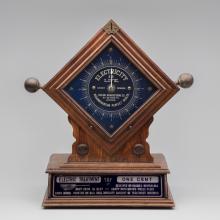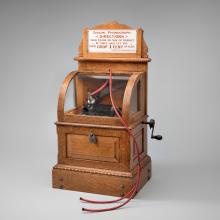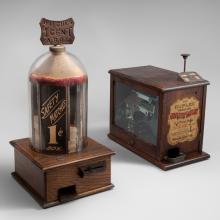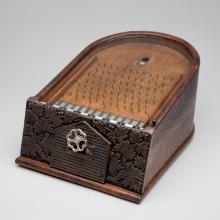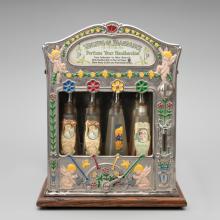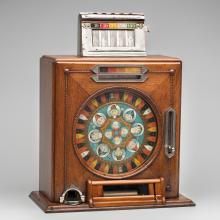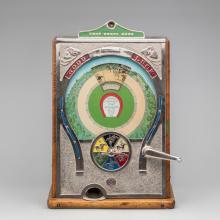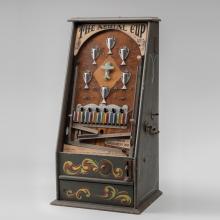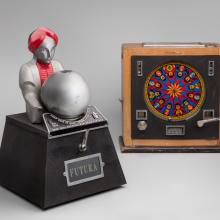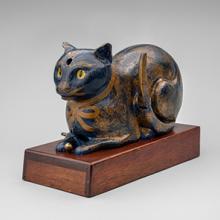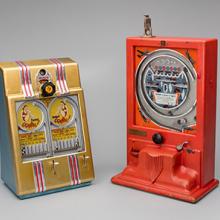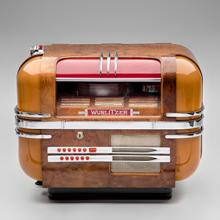International Terminal












Electricity is Life 1899
Midland Manufacturing Company
Chicago
Courtesy of Joe Welch American Antique Museum
L2017.2601.001
The first electric shock devices date to the mid-18th century, when electrical therapy was commonly administered as a treatment for nervous disorders. Early electric shockers generated current by mechanical friction, and by the 1850s, electric shock machines drew increased voltages from circuits based on a battery and induction coil. Electrical therapy was implemented through portable devices by traveling showmen, and in larger, more theatrical versions including electric chairs and electrified mannequins. Introduced in the late 1800s, coin-operated electric shock machines operated alongside coin-controlled vending machines, scales, and strength testers. Electricity is Life by Midland Manufacturing was one of the best-selling, coin-operated electric shockers. Produced from 1899 to 1909, Electricity is Life was advertised as both a strength tester and electrical therapy device. Widely placed in saloons, this machine promoted competition among saloon clientele while offering the “healthy” benefits of electrical therapy.
Automatic Edison phonograph c. 1901
Manhattan Phonograph Company
New York
Courtesy of Joe Welch American Antique Museum
L2017.2601.003
Modern jukeboxes trace their origins to coin-operated phonographs. Marketed as automatic phonographs, these late-nineteenth-century machines combined Thomas Alva Edison’s (1847–1931) wax cylinder phonograph with a coin-operated mechanism. Edison patented the first cylinder phonograph in 1878 after experimenting with a device that recorded audible messages from a telegraph or telephone signal. This machine utilized a metal cylinder wrapped in tinfoil and was more of a novelty, as recordings quickly degraded after a few plays. Edison’s Improved Phonograph followed a decade later with wax cylinders that greatly increased the life-span of recordings. During the 1890s, electrically operated automatic phonographs were produced by various manufacturers under license from Edison. Nicknamed “nickel-in-the-slot” machines, they appeared in arcade parlors across the United States alongside Kinetoscopes, another Edison invention that played short movies from 35 mm film.
Safety match vendor c. 1906 | The Duplex U.S. postage stamp vendor c. 1912 |
Coin-operated vendors did not require their owner-operator to be present for every sale. When placed in the appropriate location, these robust machines only had to be filled, maintained, and protected from theft to be profitable. Vending machines were offered with various designs and mechanisms to suit operators and their clientele. During the early twentieth century, these compact and simple, coin-operated vendors were placed atop the counters of stores, restaurants, and bars across the United States. Countertop vending machines dispensed small products that were best suited to sales of a single item. Postage and postcard machines conveniently vended items for mail correspondence outside of the post office, such as the Duplex stamp vendor, which fed one- and two-cent stamps from rolls behind glass sides. Jackson Vending’s safety match vendors, popular in cigar stores, public houses, and saloons, dispensed a box of safety matches from a rotating carousel housed under a glass dome.
Log Cabin 1902
The Caille Brothers Company
Detroit
Courtesy of Joe Welch American Antique Museum
L2017.2601.014
Pinball games trace their origins to bagatelle, a fashionable eighteenth-century French table game. Bagatelle was developed from billiards, and utilized an inclined playing field with central pockets shrouded by pins. Using a cue and ball, bagatelle players deflected indirect shots towards an arched backstop. Skilled shots made their way directly into high-scoring pockets, while others bounced downward from pin to pin, left to chance for a score or additional shot from pockets in the lower trough. Bagatelle was also found in taverns, home parlors, and saloons throughout England and the United States. In 1901, Caille Brothers of Detroit patented Log Cabin, a nickel-operated bagatelle game and trade stimulator. Log Cabin features a spring-loaded plunger for shooting and pioneered the mechanical ball lift—an important feature of modern pinball machines. This version of Log Cabin offered $1 for the central shot, or between two and five cigars from alternating pockets in the lower trough.
Whiffs of Fragrance 1916
Mills Novelty Company
Chicago
Courtesy of Joe Welch American Antique Museum
L2017.2601.005
The decoration and function of early vending machines was designed to influence an operator to purchase the device and to attract patrons and keep the machine profitable. Early coin-operated vendors advertised their wares with creative mechanisms and decorative motifs, often housed in brightly plated and painted metal cases. Mechanical operation was part of the allure, and many machines featured visible mechanisms that dispensed items behind glass windows and enclosures. Some of the more interesting coin-operated vendors dispensed metered amounts of perfume and cologne from a liquid-filled reservoir. For a penny, one could perfume their handkerchief with Whiffs of Fragrance, a decorative machine adorned with cherubs that dispensed perfume from color-coded flowers.
Brownie c. 1902
Watling Manufacturing Company
Chicago
Courtesy of Joe Welch American Antique Museum
L2017.2601.040
Prior to Prohibition and the Volstead Act of 1919, gambling was a mainstay of the saloon. Patrons played card games such as poker, wagered on bagatelle and billiard games, and bet on the outcome of coin-operated, mechanical horse racing and strength testing devices. Payout slot machines simplified gambling and functioned automatically. Played by an individual or in a group, slot machines dispensed rewards for winning bets with minimal oversight by the owner. Early slot machines incorporated a vertically mounted gaming wheel marked by segmented colors. Freestanding models in ornately carved oak and walnut cabinets stood over five feet high and were aesthetically impressive devices. When space was at a premium, saloon owners installed machines similar to the larger slots atop their bars. This countertop model by Watling features an optional music box and is decorated with characters from the Brownies cartoon series by Palmer Cox (1840–1924).
Good Luck Race Horse 1931
Watling Manufacturing Company
Chicago
Courtesy of Joe Welch American Antique Museum
L2017.2601.035
Horse racing is one of the world’s oldest sports. Its roots trace back to the Olympic Games in Greece, when chariot racing was introduced around 640 BCE. Modern flat-track racing gained popularity in England during the late 18th century with inauguration of The Derby Stakes (1780), and then in the United States with the Belmont Stakes (1867) and Kentucky Derby (1875). Counter games and trade stimulators capitalized on the popularity of horse racing. Patented in 1929, Good Luck Race Horse is a dial machine based on earlier wheel-mechanism trade stimulators from the 1890s. Good Luck Race Horse featured six horses and a six to one odds of a prize from the operator or merchant.
Aerial Cup c. 1935
maker unidentified
Courtesy of Joe Welch American Antique Museum
L2017.2601.021
Introduced in 1931, pinball was a pop-cultural phenomenon. Early pinballs, such as Automatic Industries’ Whiffle Board and Gottlieb’s Baffle Ball, were countertop, marble-shooting games based on bagatelle boards. Like bagatelle, they utilized a slanted playing field with scoring pockets surrounded by pins. The first generation of pinball games did not incorporate flippers—they relied on the skill of the player to shoot a marble or ball towards an arched backstop for scoring. This game is a smaller, upright variation of a standard, mid-1930s pinball machine. Influenced by Genco Corporation’s Silver Cup, it was likely a prototype for a game that was not mass produced. The trophy cups, lower trough, and mechanical parts of Aerial Cup were salvaged and modified from other pinball machines.
Futura 1950s | The Gypsy Fortune Teller 1934 |
Early fortune-telling machines ranged in complexity from simple, countertop devices to automated tellers with wax-cylinder audio recordings. Over time, coin-operated scales, slot machines, and even napkin dispensers incorporated fortune-telling features. Fortune-telling was so fashionable that some machines, such as The Gypsy Fortune Teller, advertised the subject and did not actually offer a fortune. Based on the roulette wheel, this gum vendor and trade stimulator features colorful graphics depicting a fortune-teller and crystal ball. Each penny played on The Gypsy Fortune Teller dispensed a ball of gum, with prizes for winning suits available behind the counter. Other fortune-tellers kept pace with new technologies. The countertop Futura fortune machine illuminates its predictions from a roll of 35 mm film inside, visible through a lighted window atop a plastic “crystal ball.”
Lukat “The Lucky Cat” 1952
Lu-Kat Novelty Company
San Francisco
Courtesy of Joe Welch American Antique Museum
L2017.2601.028
Modern chewing gum has its roots in the ancient Aztec and Mayan practice of chewing chicle, a rubbery substance harvested from sapodilla trees. In the 1880s, New York inventor Thomas Adams (1818–1905) introduced chicle-based chewing gum to the United States from Mexico and founded the Adams Gum Company. By 1888, Adams had installed coin-operated machines in New York City’s elevated railway stations to sell his Tutti-Frutti chicle gum. The coin-operated mechanisms of Adams’ early machines were easily tripped by metal slugs and hairpins. Tamper-resistant versions followed, and as gum vending machines came to market in greater numbers, companies introduced decorative and novel designs to distinguish their vendors. One of the rarest novelty gum vendors, Lukat is an example of a late-era trade stimulator and dispensed a prize ticket from its mouth with each gumball.
|
Oomph 1947 |
Zoom 1941 |
Allwin games were produced in large numbers throughout Europe for more than half a century. These simple, coin-operated amusements fired a spring-loaded ball through a vertically mounted, circular racetrack with scoring holes at the center. In the 1930s, spiral racetrack games similar in design to European Allwins made their way onto the counters of American penny arcades, bars, and drugstores. Groetchen Manufacturing of Chicago successfully marketed Zoom, a spiral game with patriotic graphics inspired by the Second World War. One ball was dispensed for each penny and returned for a free play with each “hit” scored. As manufacturers re-tooled to support the war effort, production of coin-operated amusements slowed dramatically. In 1947, Daval Products of Chicago introduced Oomph, a double-spiral racetrack based on pre-war, American spiral games.
Wurlitzer Model 41 1940–41
Rudolph Wurlitzer Company
Cincinnati, Ohio
Courtesy of Joe Welch American Antique Museum
L2017.2601.039
Amplification allowed for significant increases in jukebox volume, entertaining large groups of people for only a nickel per song. From the mid-1930s through the 1950s, the Rudolph Wurlitzer Company of New York reigned supreme. Under the guidance of designer Paul M. Fuller (1897–1951), Wurlitzer jukeboxes incorporated modern plastics and phenolic resins that showcased light, color, and form in striking, Art Deco designs. Fuller combined traditional wood veneers and bright-metal plating with backlit bubble tubes, transparent plastic housings, and rotating light columns in some of the most iconic coin-operated machines ever made. Wurlitzer also marketed a line of tabletop models for smaller businesses. These compact jukeboxes employed a twelve-selection mechanism that raised or lowered 78 rpm records arranged in a stack to the desired disc.
